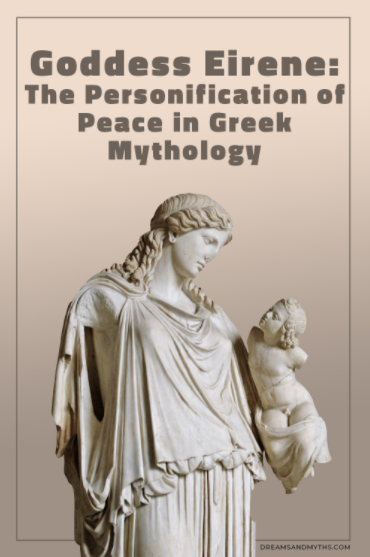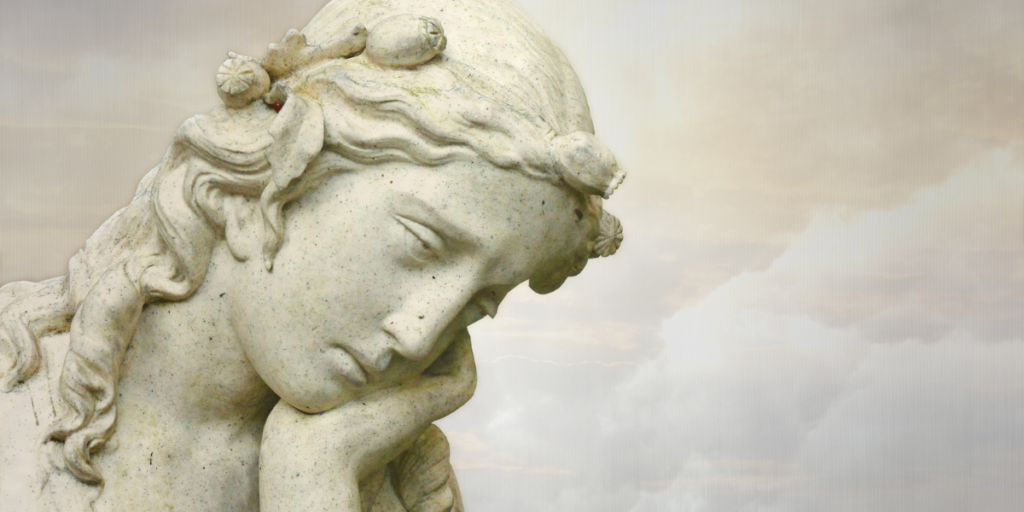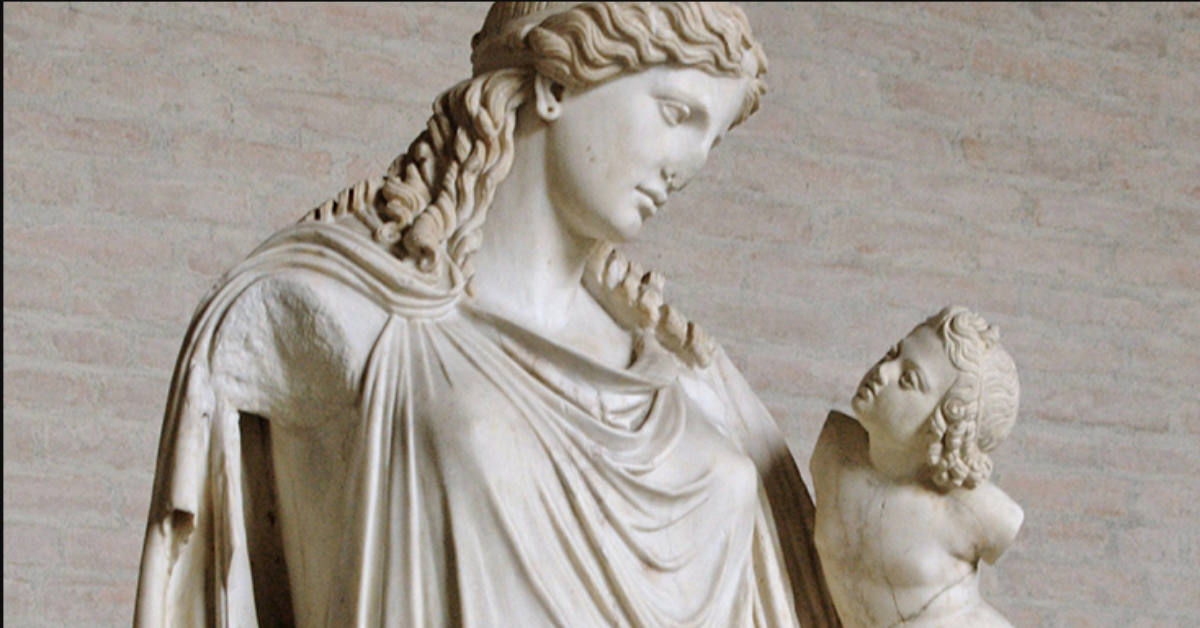Goddess Eirene is the personification of peace in Greek Mythology and is also one of the 12 Horae goddesses.
The 12 goddesses together represent the 12 months and the 12 hours of the day. Therefore, they are also called the goddesses of seasons, guiding Helios, the sun god, traveling through the sky, and dividing day into different natural parts of time.
The ancient Greek poet also compares goddess Eirene to the spring season through the well-known epithet “Hora Thallo.” Hora Thallo literally means “Green Shoot,” which resembles Spring – the season of rebirth and growth of new plants.
Let’s see the family tree of Eirene, her parentage, and let’s try and explore the meaning of her statue along with her significance in Greek and Roman Mythology.
The Origin of the Goddess Eirene

Eirene was born to Zeus, the king of Olympian gods, and his second wife, Themis (Titan), the personification of Justice.
Zeus and Themis are the ultimate origins of the three major Horae – Eirene, Dike, and Eunomia.
Therefore, Goddesses Eirene, Dike, and Eunomia are sisters as well as children of Zeus and Themis.
Themis was one of the 12 offsprings of Gaia – the personification of Earth and Uranus, who is the personification of the sky. And is also believed to be the father of all first-generation Titans.
Dike is the goddess of justice and law, represented by Scales of Justice. Whereas Eunomia is the minor goddess of law.
Zeus and Themis are also believed to be the parents of the three Moirae. In English, the Moirae are also known as the Fates, meaning the incarnations of destiny. These are Clotho, Lachesis, and Atropos.
Clotho spins the thread of life using her spindle, Lachesis uses a measuring rod to gauge the thread of life assigned to every person, and Atropos signifies death, who cuts the thread of life.
Eirene as the Greek Goddess of Seasons

Homer’s Illiad describes Horae to be the protectors of the gates leading to Mount Olympus – the home or the abode of all the Greek gods and even the throne of Zeus – the king of all Greek gods.
So, this makes Eirene the goddess who is also the guardian of the entrance of Mount Olympus. And the change in seasons is represented by her being or acting as a gateway to the next season.
Eirene’s Representation in Art
Eirene, in art, is represented as a beautiful, graceful woman carrying a cornucopia, a scepter, and a torch called the rhyton.
Cornucopia is the horn of plenty, usually associated with the goddess of the harvest, Demeter. However, it later evolved to be associated with many other gods. And it signifies or symbolizes abundance.
The scepter is a wand carried by Eirene, signifying royal authority. And the rhyton is an animal-shaped drinking vessel or cup used in ancient ceremonies.
Eirene was a goddess who gained immense respect among the Athenian people. To celebrate Common Peace and victory over Sparta in 275 BC, Eirene’s bronze statue was erected in her honor. It was a bronze statue created by the Greek sculptor, Cephisodotus or Kephisodotus, who is also known as the father or the uncle of another popular Greek sculptor, Praxiteles.
Did you know – Common peace is a 4th-century Greek political thought described as permanent peace in Greek city-states. And Athenians erected statues of Eirene as part of the cult for peace.
The Meaning of the Statue of Eirene
The statue essentially translates as peace and wealth. It shows Eirene carrying an infant Plutus on her left arm. Plutus is the god of wealth, plenty, or abundance and also the son of Demeter, the goddess of harvest and agriculture.
The bronze statue was created between 375 BC to 371 BC. It signifies the narrative and is used to convey the abstract meaning that peace is the mother of wealth. It also indicates that, in times of peace, bronze as a material can be utilized in making artwork and not just for making weapons.
This statue also influenced the future representations of the Virgin Mary and the baby Jesus.
Moreover, it also had a great impact on one of the statues of Hermes and Dionysus. The Hermes- Dionysus statue has a baby interacting with the elder god or the goddess. One notable observation is that the baby does not have the regular, normal proportions or the look and feel of a baby from the mortal world. This points to the fact that the baby is also a god.
Eirene, in the bronze statue, is heavily draped. Therefore, the heavy clothing signifies or gives her a very motherly or maternal vibe. The statue shows Plutus looking at Eirene with profound trust and love and Eirene gazing back at him with all motherly love. It symbolizes that wealth (Plutus) flourishes under the protection of peace.
One of the best existing copies of the bronze statue of Eirene is created out of marble by Cephisodotus, the elder, and is currently in Munich Glyptothek.
Did you know – Generally, marble was the preferred material used to sculpt statues of goddesses. This is because it was believed that women mostly spent their time indoors, which made their skin really pale. The use of marble significantly represents the divine paleness of their bodies.
Eirene’s greatest value was that she was the epitome of peace and had the ability to strike a golden balance among the bad virtues of all Greek gods and goddesses that often led to wars and vices.
Eirene’s Roman Equivalent – Pax
Eirene’s worship dates back to the Bronze age. This later extended to the Greek states after the rise of the empire in Athens. However, the Romans had their own representation of goddess Eirene called the Pax Romana on their coins. Coins depicting Pax were first minted in 137 BC to honor a treaty between Rome and Epirus post the Samnite wars.
In the coins, she is depicted as a woman symbolizing prosperity and peace. This is shown with the help of several commonly used farm animals next to her. Lush fields and plenty of harvest and peace are conveyed through these coins.
During the rule of emperor Augustus, Eirene or Pax was extensively worshipped. She held a special significance as her imagery was used to help establish peace and stability after many, many years of constant fighting and warring.
The Ara Pacis altar dedicated to Pax, the Roman goddess of peace, was a structure commissioned in 13 BCE marking Augustus’s return from the provinces of Gaul. Augustus had spent three years heading the administration of the region. As a symbol of respect to Pax, he decided to place the structure near his mausoleum on Campus Martius.
This is one of the many reasons why Pax was heavily worshipped during the reign of Augustus, and her imagery was also found in the coins circulated during that period.
The devotion and worship continued even during the reign of Vespasian of the Flavian dynasty, who eventually became successful in putting an end to the civil war. To mark the end of unrest and instability in Rome, Vespasian erected a temple honoring Pax, associating it with ultimate peace. This temple, therefore, is rightly called the Templum Pacis.
Christianity and the Worship of Eirene
Christianity started flourishing and rising during the Pax Romana, a period of peace in Rome, from 27 B. C. E to 180 C. E. It was a period of peace in all aspects.
Because it laid the foundation for peace where it helped with the establishment of better governments, excellent literature, and engineering, plus the formulation of better laws. Christianity came to the forefront during this time of peace and stability.
Romans were against the spread of Christianity. The Roman Emperor Nero was the first one to persecute early Christians in AD 64. Despite persecutions, Christianity relentlessly continued to spread its teachings throughout the Roman Empire. Because Christianity refused to be compliant with the ancient Roman ways of worship.
Jesus’s teachings of Christianity turned out to be more impactful that lasted with people for a long time to come. The 12 disciples of Jesus simplified the religion and spread it successfully with immense passion across different parts and regions of the world. The messaging of Christianity was believed to be more thought-provoking and impactful.
So, the significance of Pax Romana later faded with the extreme popularity of the new religion and new spiritual leadership.
Verdict
Eirene, the goddess of peace, and the Pax Romana, the Roman equivalent, both served a great deal in bringing peace, abundance, and prosperity to the lives of the people.
It symbolized absolute peace, the end of wars, rebellions, the end of slavery, reduced violence, pacified people, and even brought ultimate stability to the society at large.
Bonus Read – Liked what you read?? Here are more interesting things about Greek myths, stories, and books
